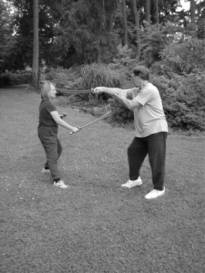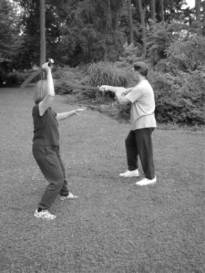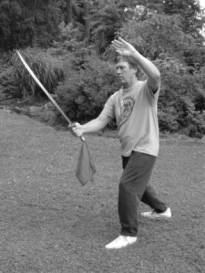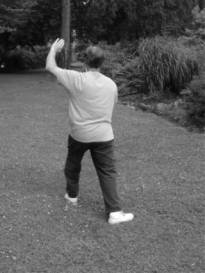 Gilman Studio On-Line Lessons
Gilman Studio On-Line Lessons
Yang Style
Tai Chi Dao/Saber/Broadsword
This Lesson Contains:
Movement # 12 – Fair Lady Works At Shuttles
This movement is almost exactly the same as in the Long Form. The first part is a follow through to the previous movement. I add a poke to the opponent. Most people do not add this poking movement, but go directly into the side step. The second part is a block of the opponent’s attack to my neck. I then grab her sword hand and use a large swinging motion to cut her neck or shoulder.
 I poke towards the opponent’s face.
I poke towards the opponent’s face.
This is more an extension of the previous movement. If I miss the wrist of the opponent, I follow with a poke to her upper body.

 1) The opponent attacks from my left side.
1) The opponent attacks from my left side.
2) I block and start to step in. Notice the angle of my saber and that I use the flat side of the blade to block with. I am guarding from the top of my head to below the shoulder.

 1) I step in and grab Stephie’s saber hand.
1) I step in and grab Stephie’s saber hand.
2) I use a downward cutting motion to her neck or shoulder. This swinging motion around my head gives momentum to make this a very strong cut.
Shift the weight back onto the left foot and pull the right toe in to empty step. The body faces slightly to the right of east.
As the body withdraws, the right arm thrusts outward until the arm is basically straight without being locked. The left hand stays in basically the same position, but turns to face the right elbow. The body withdraw and the trust happen at the same time.
Focus on the tip of the saber.

 Protecting the head from the attack.
Protecting the head from the attack.
Step to the left side with the right foot. This is called side step. The weight remains on the left foot. The right toe faces slightly to the right of east. Be careful not to block your left foot from being able to step in its new direction.
The torso doesn’t change direction at this point. I want to keep torque in the torso for my cut.
The right arm swings up and to the left, bringing the handle up above the head. First the right elbow and shoulder are raised while the tip of the saber is dropped. The hand is making a counterclockwise circle. This movement has the feeling of pushing something to the left with the right side of the blade. The left hand remains on the right forearm to give support and keep it out of the way for the moment.
Focus on the side of the blade for blocking.

 I step in and grab the opponent’s saber hand and start my cutting motion.
I step in and grab the opponent’s saber hand and start my cutting motion.
Step with the left foot halfway between east and north. Just touch down the heel. Be sure to step wide enough to the left so the foot can act as a brake for the strong movement that follows. Sink the energy into the right kua. The torso still faces slightly to the right of east in order to keep torque in the waist.
The left hand reaches, as if grabbing, toward the front, and slightly upward, ending palm outward, head level, on the left side of the body. The right saber hand is swinging around the head to gain momentum in order to strike on the opponent’s left side. Keep the elbow as relaxed as possible. The blade hangs down. Try not to let the blade point too far away from the body.
Focus on the left hand to grab the opponent’s hand.

 I cut the opponent’s neck. This is a strong, downward chopping motion. Many fighters in the era of sword fighting wore leather or metal armor, especially on vulnerable areas. This cut with a heavy saber was designed to cut through heavy protective gear.
I cut the opponent’s neck. This is a strong, downward chopping motion. Many fighters in the era of sword fighting wore leather or metal armor, especially on vulnerable areas. This cut with a heavy saber was designed to cut through heavy protective gear.
Shift the weight onto the left foot, and as you do, turn the torso until the nose points toward the left knee. The final direction is halfway between north and east.
The left hand remains pretty much in the same place. The right arm chops down and to the left so the cutting edge of the blade ends about your neck level on the right side of your body. The length of your saber determines the final placement of your right hand. Keep your elbows and shoulders relaxed.
Focus on the cutting edge of your saber.


